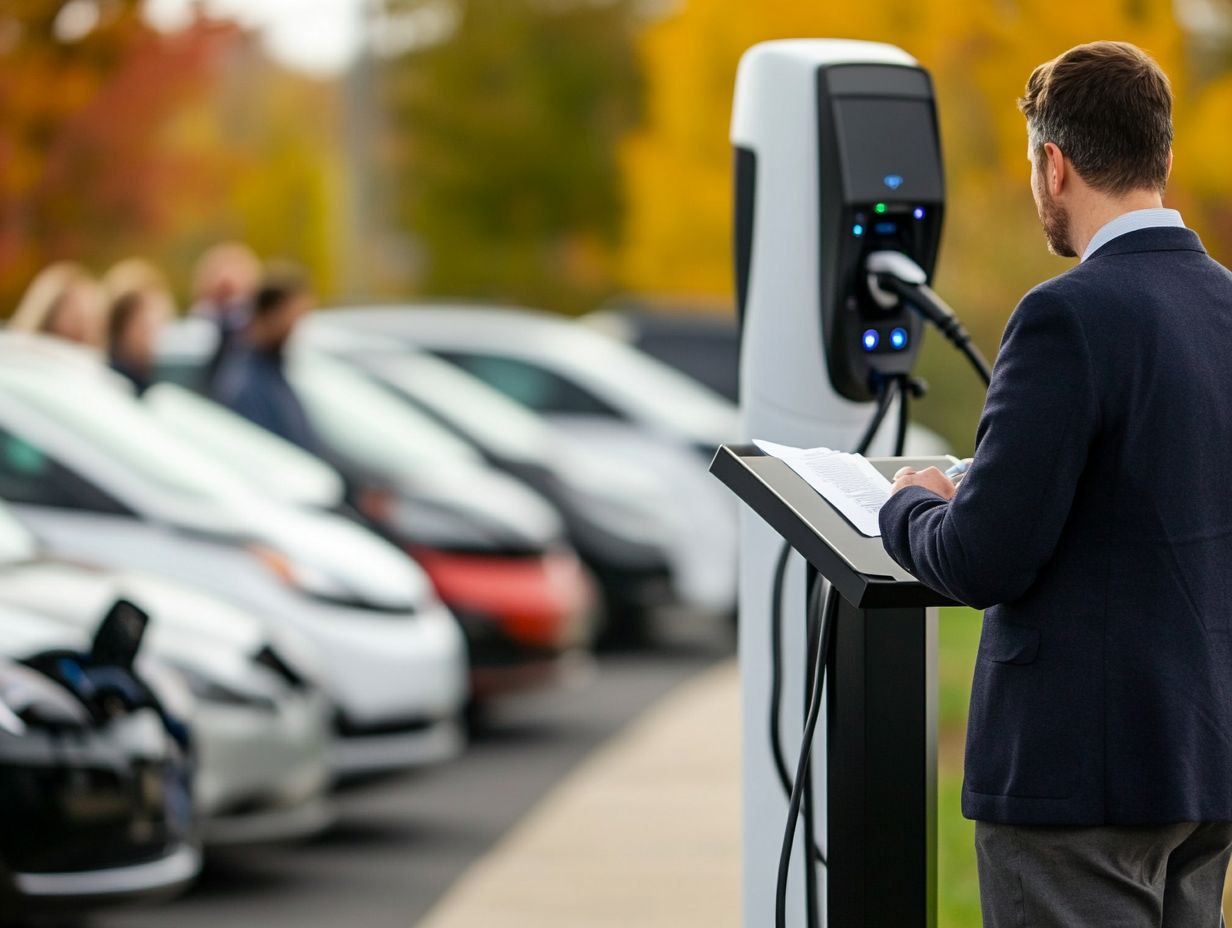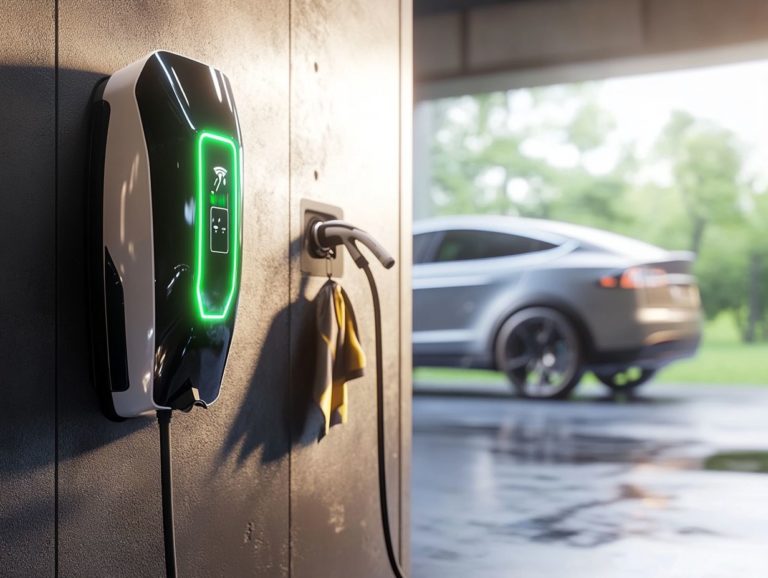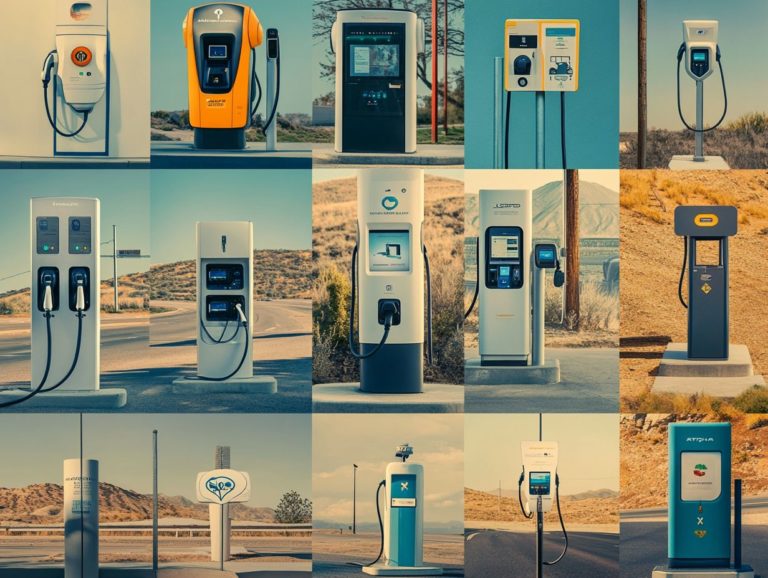The Role of Government in Charging Infrastructure
As electric vehicles (EVs) continue to gain momentum, the significance of a robust charging infrastructure cannot be overstated.
Join us as we explore the vital role that charging stations play in the future of electric vehicles! This article assesses the current landscape regarding the availability and accessibility of these essential facilities and highlights the government incentives designed to bolster their development.
It also explores regulations shaping this evolving sector and discusses promising advancements that aim to enhance charging networks. Discover how these components are pivotal for creating a sustainable automotive future.
Contents
- Key Takeaways:
- The Importance of Charging Infrastructure
- Current State of Charging Infrastructure
- Government Incentives for Charging Infrastructure
- Regulations and Policies for Charging Infrastructure
- Future of Charging Infrastructure
- Frequently Asked Questions
- What is the role of government in charging infrastructure?
- Why is government involvement necessary for charging infrastructure?
- How does government funding support charging infrastructure?
- What incentives does the government offer to support charging infrastructure?
- What regulations does the government put in place for charging infrastructure?
- How does government involvement in charging infrastructure benefit the environment?
Key Takeaways:

- The government plays a crucial role in developing and implementing charging infrastructure for electric vehicles.
- Availability and accessibility of charging stations are key factors for adopting electric vehicles, and government policies can help improve them.
- Financial support and tax incentives from the government can encourage private companies to invest in charging infrastructure, accelerating its growth and expansion.
The Importance of Charging Infrastructure
The significance of charging infrastructure in fostering electric vehicle (EV) adoption is paramount. It acts as a cornerstone for sustainable mobility and plays a vital role in reducing transportation emissions.
As the demand for clean transportation escalates, expanding charging networks becomes critical. This is particularly relevant given the federal backing from initiatives like the Bipartisan Infrastructure Law, designed to strengthen charging infrastructure across the United States.
State governments and utility providers are stepping up to enhance the charging landscape. They are forming collaborations between government and private companies to ensure that all EV users enjoy a reliable and accessible charging experience.
Why It Matters for Electric Vehicles
The issue of charging infrastructure is crucial for the successful integration of electric vehicles (EVs) into modern transportation systems. Without a robust and accessible network of charging stations, potential users might hesitate to make the switch due to concerns about range anxiety and the hassle of locating charging points.
This accessibility is essential in boosting EV adoption rates. More drivers can become comfortable knowing they can conveniently recharge their vehicles. A widespread charging infrastructure not only enhances the user experience but also plays a significant role in lowering transportation emissions, paving the way for a transition to cleaner energy sources.
By facilitating the shift to EVs, charging infrastructure aligns with broader clean transportation goals, ultimately fostering an economy that prioritizes sustainability and efficiency in urban environments.
Current State of Charging Infrastructure
The current landscape of charging infrastructure in the United States reveals a dual narrative of remarkable progress alongside persistent challenges. As the EV charging network evolves to cater to the growing demands of electric vehicle users, it skillfully navigates the complexities of regulatory and logistical hurdles.
Availability and Accessibility

Availability and accessibility are crucial elements of the charging infrastructure that significantly impact user experience and the overall rate of electric vehicle (EV) adoption.
As you consider making the switch to an electric vehicle, the current distribution of charging stations becomes essential. It s important to assess whether these stations are strategically located in urban centers, suburban neighborhoods, and rural areas to cater to the diverse needs of all potential users. Accessibility is equally vital; think about how easily you can locate and use these charging points.
Utility providers are enhancing the charging network, ensuring it is robust enough to meet the growing demand as EV ownership expands. This combined emphasis on geographic availability and an improved user experience will ultimately make it easier to integrate electric vehicles into daily life.
Government Incentives for Charging Infrastructure
Government incentives significantly boost the development of charging infrastructure. These initiatives range from diverse funding programs to enticing tax breaks. They are designed to encourage investments in electric vehicle charging solutions.
Financial Support and Tax Incentives
Financial support and tax incentives are crucial for driving investment in EV charging infrastructure. By leveraging various forms of financial assistance, such as grants, subsidies, and low-interest loans, you can lower the upfront costs of installing charging stations.
Tax credits and deductions aim to motivate businesses and property owners like you to invest in these essential facilities. This makes it easier for you to contribute to a robust and interconnected charging network.
Such encouragement accelerates the adoption of electric vehicles and plays a vital role in transitioning to cleaner transportation solutions. Implementing these programs is essential for engaging partnerships between government and private companies and promoting sustainable energy resources.
Regulations and Policies for Charging Infrastructure
Regulations and policies surrounding charging infrastructure significantly shape its development and implementation. They influence how partnerships between government and private companies can foster the growth of electric mobility, highlighting the role of governments in promoting EV sustainability.
By understanding these frameworks, you can better navigate the landscape and find opportunities for impactful collaboration.
Impact on Development and Implementation

Regulations profoundly impact the development and implementation of charging infrastructure. They shape the pace and effectiveness of EV infrastructure deployment.
These regulations establish guidelines covering everything from site selection to funding mechanisms. Specific EV policy frameworks, like those promoting partnerships or offering financial incentives, can significantly speed up the rollout of charging stations.
Zoning laws and permitting processes can either facilitate or hinder new charger installations. Creating a clear regulatory landscape allows authorities to streamline development, ensuring that charging networks are widely available and strategically positioned to meet the needs of EV users.
Knowing these regulations will empower you to build a reliable charging infrastructure with confidence.
Future of Charging Infrastructure
The future of charging infrastructure is set for a remarkable transformation. This change is driven by cutting-edge technological advancements and strategic expansion plans. This evolution will greatly enhance the overall electric mobility landscape and offer a promising outlook for sustainable transportation.
Technological Advancements and Expansion Plans
Technological advancements in charging infrastructure will revolutionize your EV charging experience. Utility providers expansion plans will significantly enhance the charging network available to you.
These innovations promise not only faster charging times and improved accessibility but also aim to cultivate a more sustainable energy ecosystem. With the integration of intelligent systems that manage energy use more efficiently and renewable energy sources, optimizing your charging schedule based on energy availability is becoming increasingly feasible.
This aligns perfectly with utility providers’ efforts to deploy extensive networks of charging stations in both urban and rural areas.
As these developments unfold, the landscape for electric vehicle owners will transform dramatically, leading to a more convenient and environmentally conscious mode of transportation.
Frequently Asked Questions
Explore your options to invest in charging infrastructure today!
What is the role of government in charging infrastructure?

The government plays a crucial role in establishing and maintaining charging stations for electric vehicles, as highlighted in the role of governments in promoting EVs. It provides essential funding, incentives, and regulations to support this growing infrastructure.
Why is government involvement necessary for charging infrastructure?
Government involvement is essential because charging stations benefit everyone in society. Without support, private companies might lack the motivation to invest in this vital service.
How does government funding support charging infrastructure?
Government funding helps build new charging stations and upgrade existing ones. It also provides subsidies to electric vehicle owners, making charging more accessible and affordable.
What incentives does the government offer to support charging infrastructure?
The government offers tax credits, rebates, and financial incentives to individuals and businesses investing in charging stations. These perks encourage private investment and growth in this sector.
What regulations does the government put in place for charging infrastructure?
The government establishes regulations for how charging stations are installed, operated, and priced. These rules ensure that stations remain safe, reliable, and accessible for everyone.
How does government involvement in charging infrastructure benefit the environment?
By promoting electric vehicle use through accessible charging stations, the government reduces emissions and fights climate change. This also fosters clean energy development and lessens reliance on fossil fuels.





